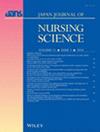Does an early hands-on breastfeeding intervention by midwives affect nipple pain incidence? An observational pilot study
Abstract
Aim
To describe the timing and characteristics of midwives' hands-on interruptions of newborns' behavior while in skin-to-skin contact during the first hour after birth and to elucidate the relationship between these hands-on interruptions and the incidence of nipple pain during the first 4 days postpartum.
Methods
An observational pilot study was conducted at a Baby-Friendly® hospital in Japan from 2016 to 2018. Iterative analysis of video recordings from a larger study of the behavior of newborns while skin-to-skin with their mothers in the first hour after birth found 16 full-term newborns who were born vaginally and that met the inclusion criteria of a midwife's hands-on intervention (HOI) interrupting the infant's progress toward breast self-attachment. The timing of the HOI and the stage of the newborn's progress through Widström's 9 Stages was noted by two research assistants who had been blinded to the medical records. The degree of nipple pain after breastfeeding was self-evaluated by mothers each day during their hospitalization. All data were statistically analyzed.
Results
Interrupting the infant's progressive behaviors in the first hour after birth by midwives' hands-on “help” to breastfeed, may increase nipple pain during the 4 days after birth. One hundred percent of the mothers reported nipple pain in the postpartum with the highest pain reports occurring on day 4.
Conclusion
Interrupting skin-to-skin contact with HOI does not decrease the incidence of nipple pain during the first days postpartum. HOI for newborn infants was not shown to support breastfeeding in the early postnatal period.

 求助内容:
求助内容: 应助结果提醒方式:
应助结果提醒方式:


